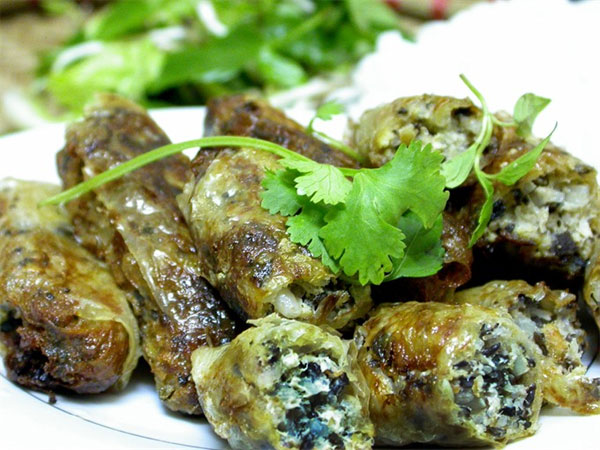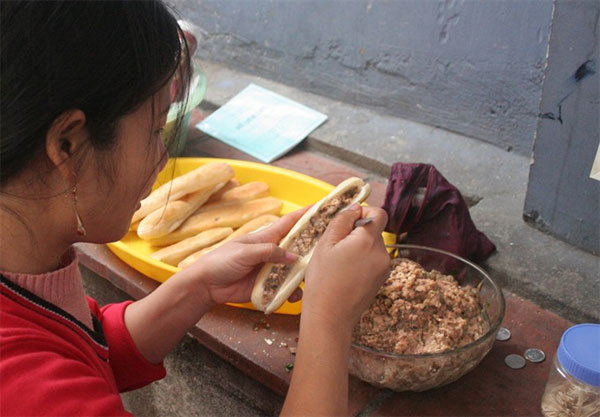Bridge – Vietnamese people have long taken pride in their banh mi, a dish named as one of the best street foods in the world by CNN (American Cable News Network), and listed in the Oxford English dictionary as ‘a Vietnamese snack consisting of a baguette (traditionally baked with both rice and wheat flour) filled with a variety of ingredients, typically including meat, pickled vegetables and chili sauce’.
 |
|
Full of flavour: The ingredients of crab spring rolls: crab meat, minced pork, egg, mushrooms, bean sprouts, carrots, onions and vermicelli noodles. |
Banh mi, originally from France, has been adapted to suit Vietnamese tastes. In Ha Noi, a banh mi features a baguette – airy on the inside and crusty on the outside – stuffed with a wide selection of ingredients, including beef, chicken, pork, egg, sausage and different kinds of herbs.
Among the different versions of banh mi available in Viet Nam, the banh mi cay (spicy banh mi) of Hai Phong may be the most humble, consisting of just a baguette, some pate and a squeeze of local chili sauce.
A spicy banh mi is just a couple of fingers in width and is filled with an aromatic pate. The bread is drizzled with oil and baked over charcoal for a crusty finish. The snack costs between just VND2,000 to VND5,000 each. With a single US dollar, you could buy ten!
This cheap, convenient and tasty treat is particularly popular with students. Dropping by a little banh mi cay shop on Le Loi or Hang Kenh streets during school break time, one is sure to see groups of students in their uniforms waiting patiently for the sellers to take freshly baked baguettes from the oven.
In a modern and fast-paced city with tree-lined streets and old French architecture, these little eateries offering a humble dish are still regularly frequented by locals.
It is said that natives of Hai Phong are not so fussy with their food. They pay most attention to the quality of the meal, rather than the space itself.
Banh mi cay (spicy banh mi), also known as banh mi que (stick banh mi, for its appearance as a long stick), is so popular in the port city of Hai Phong that it has been named Hai Phong banh mi.
It is said that a woman named Hoang Thi Toan on Le Loi Street came up with the original recipe some twenty years ago.
After all these years, her little banh mi shop still serves citizens, from students and parents to office workers and tourists. The place is often buzzing with activity, and some customers buy dozens of bread sticks to take home.
The eatery has an intriguing name – ‘Bà Già’ (Old Lady).
“Initially, we called it Vinh Khanh. As our business was pretty good and our bread was well-known among local people, neighbouring households began to sell similar bread using the same name to draw customers,” said Toan.
“Customers used to call me Mrs Old Lady, so I decided that our shop should have that name too,” said Toan.
Most spicy banh mi sellers in Hai Phong make the pate at home.
Pork skin is boiled and sliced and then ground with lean pork and liver. Dried onions and garlic are stir fried in boiling oil. The mixture of ground pork, skin and liver will be seasoned with salt, pepper, a bit of sugar and then stir-fried with the onion and garlic. The chef will then put a layer of pork fat at the bottom of a mould, spoon the mixture of pate on top and steam it for about five hours, explained Toan.
“Good pate is smooth in texture, with pork evenly spread over the surface. The pate should be slightly pink in colour with white spots of pork fat. There should be flavours of liver and garlic,” said Toan.
“One thing that makes Hai Phong banh mi different from those of other areas is the chili sauce. Locals make the sauce with a mixture of chili, tomatoes, garlic and salt,” said Toan.
Nowadays spicy bánh mì shops and stalls can easily be found on the streets of Hang Kenh or Cat Cut, and in the Cot Den area.
“The banh mi of Hai Phong has become very famous. When I’m away from Hai Phong, I miss it a lot; just thinking of the snack makes my mouth water. The thin baguette with tasty pate is baked and becomes crispy. With a little chili sauce the sense of Hai Phong comes rushing back,” said Tran Thi Thu Ngan, 24, a native of Hai Phong.
“Despite the heat, the more chili sauce, the better the treat is,” said Ngan.
“Every time I travel to Hai Phong, I visit a spicy banh mi shop and eat ten pieces. I even buy fifty or a hundred to take back home,” said Le Tung Lam, 28, from Ha Noi.
Nem cua be – a taste of the sea
Hai Phong City is also famous for its seafood dishes, which include banh da cua (Hai Phong noodle soup with crab), bun ca (vermicelli soup with fish), squid and different kinds of snails. Among them, nem cua be (crab spring roll) is a highlight.
The ingredients of crab spring rolls comprise crab meat, minced pork, egg, mushrooms, bean sprouts, carrots, onions and vermicelli noodles.
The mixture is rolled in rice paper and is then fried in boiling oil until it becomes crispy.
The treat is enhanced when combined with another local specialty from Cat Hai Island – fish sauce, which has been selected as one of Viet Nam’s top condiments by the Viet Nam Guinness Book of Records.
 |
|
Crispies: Nem cua be (crab spring roll) is a highlight of Hai Phong food among banh da cua (Hai Phong noodle soup with crab), bun ca (vermicelli soup with fish), squid and different kinds of snails.
Taste of green: Hai Phong chefs often add fresh corriander to suit Ha Noi tastes. —VNS Photos Doan Tung
Simple, savoury: Among the different versions of banh mi available in Viet Nam, the banh mi cay (spicy banh mi) of Hai Phong may be the most humble, consisting of just a baguette, some pate and a squeeze of local chili sauce. |


